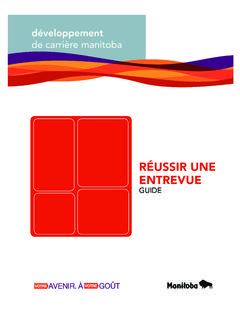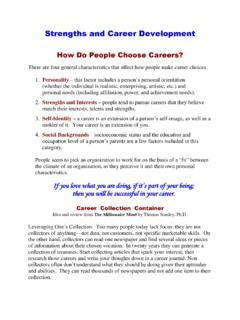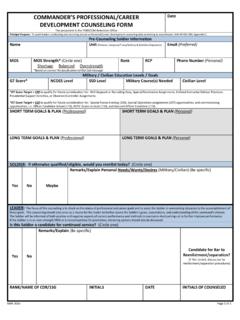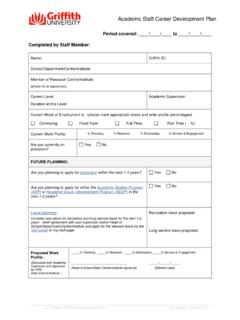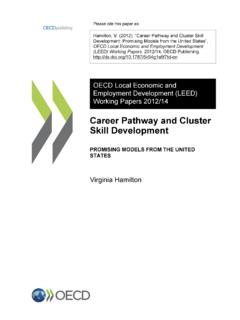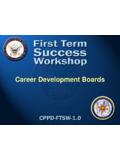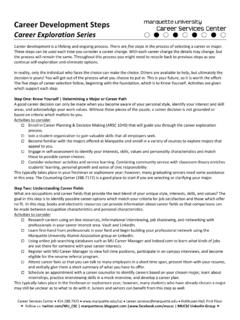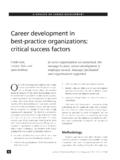Transcription of career development manitoba
1 career development manitoba A guide to planning . your career Table of Contents 2. 3. About This 3. What Is career planning and Why Is It Important?.. 5. Stages of career 6. 1. Evaluating 8. What Do I Know About Myself and How Can I Learn More?.. 8. The 8. career planning Real World 9. Start your career planning 11. 2. Exploring 25. How Can I Learn About the Job Market?.. 25. career Research 27. career 28. Exploration: What Are the Different Ways of Working?.. 30. 3. Making 31. How Can I Decide?.. 31. career Decision-Making 33. Identifying Strengths and 35. Scenario 40. 4. Setting 43. How Do I Set Goals?.. 43. 5. Implementing My 46. How Can I Take Action?.. 46. 49. Appendix A: Sample Wheels for Susan York, Frank Peters and Jennifer 50. Appendix B: Informational Interview 54.
2 Appendix C: guide 57. PAGE 1. A guide to planning your career Acknowledgements This resource package was developed through a partnership involving manitoba Entrepreneurship, Training and Trade and Life Strategies Ltd. Project funding was provided by: manitoba Children and Youth Opportunities manitoba Entrepreneurship, Training and Trade manitoba Immigration and Multiculturalism PAGE 2. A guide to planning your career Introduction About This guide This guide is filled with valuable information and activities to help you through the career planning process. your career is like a garden: it needs attention and care so that it can grow and reach its potential. The information and activities in this guide are helpful if you are: a first-time job seeker a new graduate (high school, vocational school, college or university).
3 Unemployed looking for a career change looking for career advancement interested in learning more about yourself a newcomer to Canada The activities throughout this guide will help you to stay on the road to success throughout your career /life journey. Take time to complete the activities and revisit them often. The guide is divided into sections. If you are new to career planning , it is recommended that you work through all the activities. If you have already started your career planning process, feel free to pull out only those sections that will help you. For more information about career planning , tips for success in the workplace, and other related topics, please visit If you are having difficulty with any part of the guide , another helpful resource is your local Employment manitoba Centre.
4 To find one near you call: 1-866-332-5077 or go to PAGE 3. A guide to planning your career Several symbols are used in this guide to help highlight key points, suggestions, cautions, tips and examples. indicates an example Example outlines items to remember Remember introduces an activity to complete Activity indicates things to avoid Avoid Life is the sum of all your choices. 1.. -Albert Camus 1. PAGE 4. A guide to planning your career What Is career planning and Why Is It Important? To get the most out of career planning , it's important to understand what exactly you are planning for. The word career pops up all over the place and can mean different things to different people. In this guide , career includes all of the work, learning, and leisure activities that you are involved in throughout your This means that planning your career isn't separate from planning the rest of life your work is closely connected to other life roles and skills you've developed in other life roles may be useful at work.
5 career planning is a lifelong process that focuses on making choices to help you manage your work and personal life. Good career planning requires information about you, the world of work and commitment. The world of work is continually changing. The way people work is changing with things like telecommuting, job sharing, and other ways of working becoming more common. Advances in technology have made some jobs disappear and others very different from what they once were. career planning can help you to prepare to: enter the workforce plan for education deal with changing workplace demands anticipate trends or changes plan to upgrade or maintain your skills plan for career advancement The activities in this guide are designed to help you with your career planning journey.
6 Managing your career is not a one-time decision but a series of decisions made over your lifetime. 3. ~Strong Interest Inventory Report ( ). 2. Canadian career development Foundation 3. PAGE 5. A guide to planning your career Stages of career planning This guide will walk you through the five stages of career planning : 1. Evaluating Myself learning about myself Having a clear picture of your unique talents, interests, values and skills will be the base of your career - planning journey. A great start to a brighter future. 2. Exploring Options learning about available work opportunities Once you have a clear idea of your interests, current skills and the things you value, you can start exploring options. Gather information about occupations, education and training opportunities.
7 3. Making Decisions deciding on my future path Once you have explored your options, the next step is narrowing down the work and/or training field on which you would like to focus. Take time to analyze the options you have explored and make decisions about what path you want to travel. 4. Setting Goals creating a plan You have identified your career path; now identify the steps you need to take to start moving towards your goal. Prepare an action plan and chart your course. 5. Implementing My Plan putting my plan into action Set your plan into action. Keep in mind you may have to make some changes to keep yourself on track or set a new course when unexpected opportunities arise. PAGE 6. A guide to planning your career Whether you are just starting to plan for your future, wanting to change jobs or looking to advance your career , this guide will assist you with lifelong career development planning .
8 We encourage you to revisit your decision-making often to help you stay on the road to success as you journey through your career . career planning takes some work but it is worth the effort! Having a plan can help you get where you want to go. It can also help you to navigate some of the obstacles you might encounter along the way. Some of the qualities and activities that will help you to plan and manage your career include: continuous learning flexibility persistence optimism risk-taking networking Remember financial management work-life balance PAGE 7. A guide to planning your career 1 Evaluating Myself What Do I Know About Myself and How Can I Learn More? The first step in career planning is to know yourself. Understanding all the factors that make you unique will help you to plan a career that suits your own talents, skills, attributes, interests and circumstances.
9 This section of the guide has lots of activities to help you learn more about yourself. The Wheel The Wheel is a useful career planning model used throughout this guide . The Wheel is made up of eight different sections that will help you focus and record your self-exploration activities. The top half of the Wheel is made up of external factors (ex: opportunities, experiences). The bottom half of the Wheel is made up of personal characteristics (ex: skills, interests). Reproduced with permission from career Pathways 2nd Ed. (Amundson & Poehnell, 2008). In the diagram, each section of the Wheel looks equal. Depending on your life circumstances, some sections of the Wheel might be more important to you than others. This could change at different times in your life.
10 For example, if you currently have a young family, values might be more important to you at this stage of your life. This section of the guide will focus on each of the eight areas of the Wheel. Once you complete the self-exploration activities you will be asked to record your results in The Wheel Template. You can also use the Wheel to record results from other assessments, such as interest assessments and skills assessments. After your Wheel is complete, you may notice patterns or themes in your results. These patterns or themes can help you decide on a career path. PAGE 8. A guide to planning your career career planning Real World Experiences This guide is full of information, tips, and tools to help you plan your career . Throughout the guide , individuals' stories are used to help explain examples and activities.

